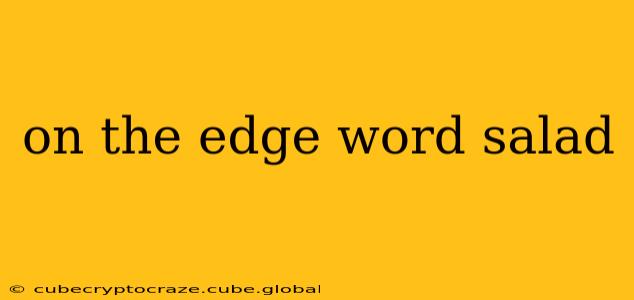On the Edge: Deconstructing the Phenomenon of "Word Salad"
The term "word salad" evokes a sense of linguistic chaos, a jumble of seemingly unrelated words tossed together without grammatical structure or logical coherence. While often associated with serious mental health conditions, the concept of "word salad" extends beyond clinical diagnoses, finding its expression in various forms of creative writing, internet slang, and even everyday conversation. This exploration delves into the multifaceted nature of word salad, examining its origins, manifestations, and the intriguing reasons behind its appeal.
What is Word Salad, Exactly?
At its core, word salad is characterized by a lack of meaningful connection between words and phrases. It's a departure from conventional syntax and semantics, resulting in utterances that are difficult, if not impossible, to comprehend. In a clinical context, it's often a symptom of thought disorders, indicating a breakdown in the ability to organize and express thoughts logically. However, the intentional use of word salad, as seen in certain artistic expressions, operates under different rules.
Is Word Salad Always a Sign of Mental Illness?
No. While word salad can be a symptom of conditions like schizophrenia or aphasia, it's crucial to avoid conflating all instances of unconventional language with mental illness. Creative writing, performance art, and even casual online communication sometimes employ word salad-like techniques for stylistic effect. The context is key in determining whether a given instance of disordered language signals a mental health concern. Intentional word salad is used to evoke specific feelings or create a particular atmosphere, often one of surrealism or absurdity.
What are the Different Types of Word Salad?
There isn't a formal clinical categorization of "types" of word salad. However, we can distinguish between spontaneous word salad, often seen in individuals with neurological or psychiatric conditions, and intentional word salad, used as a creative device. Within intentional word salad, further nuances exist: some aim for a nonsensical effect, while others may incorporate elements of neologism (newly coined words) or metaphor in unconventional ways.
How is Word Salad Used in Art and Literature?
Artists and writers have long explored the possibilities of disrupting linguistic norms. Surrealist poets and writers, for example, frequently employed techniques that blur the lines of meaning, creating dreamlike or disorienting effects. The deliberate use of unconventional language, including elements of word salad, allows artists to express ideas and emotions that might be difficult to convey through conventional means. It becomes a tool for challenging expectations and prompting reflection on language itself.
How Can I Tell the Difference Between "Word Salad" and Other Forms of Unconventional Language?
Discerning intentional word salad from unintentional disordered speech requires considering the context. Is the speaker or writer attempting to communicate a specific idea, even if unconventionally? Is there a discernible pattern or internal logic, however unconventional, within the language? Intentional word salad often manifests in controlled bursts within a larger context of more understandable language. In contrast, spontaneous word salad is usually a consistent characteristic of communication, lacking any discernible pattern or intentionality.
Is Word Salad a Form of Dadaism?
Dadaism, an art movement known for its anti-establishment ethos, certainly embraced the disruption of conventional forms and norms. While some Dadaist works might incorporate elements that could be described as word salad, it’s not a defining characteristic of the movement. Dadaism’s focus was broader, encompassing a range of techniques aimed at challenging established artistic and societal structures. Word salad, when used intentionally, could be considered one tool within a Dadaist artist's arsenal, but it's not synonymous with the movement itself.
This exploration demonstrates that "word salad" is a complex phenomenon with varied interpretations and implications. Understanding its nuances requires careful consideration of context, intention, and the potential underlying causes. While it can be a significant indicator of mental health challenges, it also serves as a powerful tool for artistic expression and linguistic experimentation.
